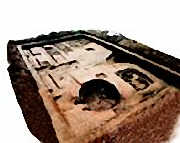In the No 2 pit were 11 huge wooden trunks -- four of which contained terracotta chariots, horses and figurines. Surprisingly, most of the painted soldiers in this particular pit are female. With their bodies painted pink and collars and wristbands painted a deep red, each female soldier has a different expression.
The terracotta soldiers were made in the three kilns unearthed around the pits, according to archeologists.
 Significance
Significance
The site's layout provides a vivid portrait of the typical aristocratic formation of cavalrymen, chariots, foot soldiers and horses in the Han Dynasty when going to war. Previously, such evidence has only been detailed in books or Han paintings and stone sculptures.
The discovery has been marked as China's "third-largest pit of terracotta warriors and horses'' and the first well-preserved terracotta warrior pit ever found in Shandong. In terms of scale, structure, and significance, the Terracotta Army of the Weishan Tomb Complex is comparable to the Mausoleum of Emperor Qin Shihuang(221-206BC) and the tombs in Xianyang, which are both located in Shaanxi Province.
